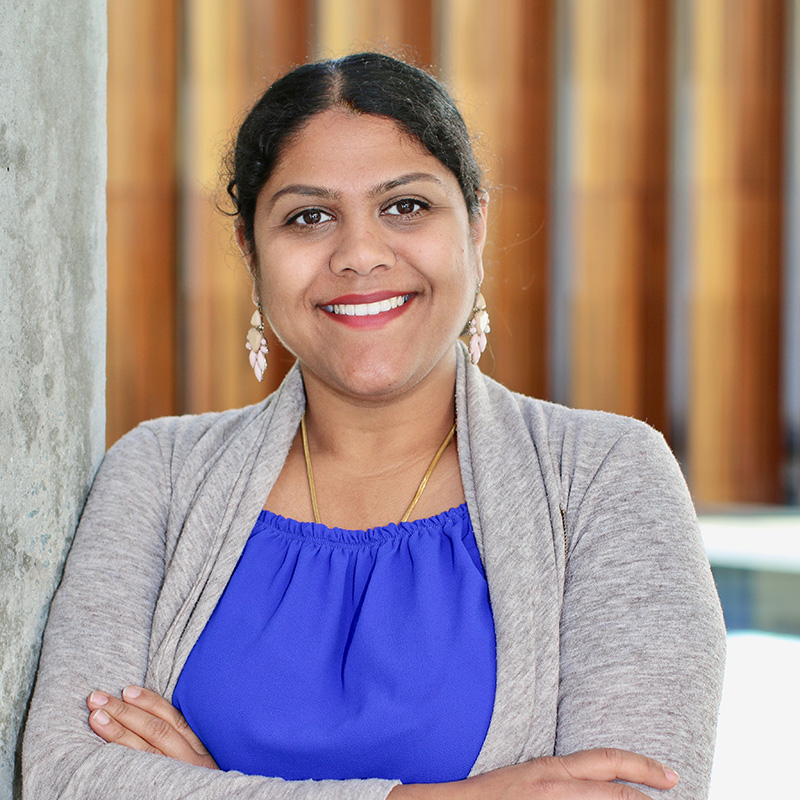As manager of the Community Teaching Lab at Scripps Research, Nitya Bhaskaran leads a vibrant program of hands-on workshops to inspire the next generation of scientists. Here, Nitya discusses her early passion for teaching, the importance of science communication and how to stay resilient in the face of failure.

Who were some of your scientific role models growing up?
I was raised in Australia and I distinctly remember my second grade teacher giving a lesson one day on clouds. I was fascinated that they had different names and shapes, and that people could predict which clouds were coming. My curiosity flourished from there and I’m sure I was an annoying child asking all the most random questions. I’m sure there’s a familial element to this curiosity as well. My dad is an engineer, who seems to be a brainiac in so many different areas. While he absolutely loves physics and chemistry, I thought I would be different and pursue the biological sciences. Together, we might make a pretty good trivia team!
How did you get involved with teaching?
I’ve tried to engage in different aspects of teaching throughout my educational path. Even in high school I was a peer tutor for the disadvantaged Aboriginal community in Australia. Mentoring became a big focus during my master’s degree in San Diego, where I was asked to be a teaching assistant (TA) for introductory biology. My science expertise was in microbiology, so a big challenge was having to teach concepts from fields that I was less familiar with, such as ecology and physiology. An even bigger challenge was trying to make this science sound fun and important to students who were not “majoring” in biology.
What is the Community Teaching Lab and what attracted you to Scripps Research?
The Community Teaching Lab is a special laboratory space on campus that can provide local San Diego students, ranging from middle school to community college, with real-world experience in a research environment. It’s fully equipped with necessary supplies and high-tech equipment, as well as complemented by different classroom curricula. When I applied for this position at Scripps Research, the job description was more of a basic, part-time lab manager role. When I came in for the interview, though, the institute was referred to as this interdisciplinary community of researchers. They were willing to let me gain experience with all of these different people and they mentioned that I would be able to teach. I was excited at the notion that I could create learning programs for students and turn the lab into the teaching space that it is today.
What are some of the key strategies for communicating science to students?
I think the situation is similar to when you’re trying to make friends. You’re trying to convince those around you that what you’re talking about is interesting and relevant to their lives. I try to show that the scientific method is universal. Not only does it apply to complex models in all kinds of disciplines, but even the things we do on a daily basis require trial and error and looking at evidence. One important thing I want the scientists-in-training to understand is that it’s quite normal for experiments to not work or give you a negative result. People often see that as failure, but what really matters is not how good the data is, but how well you communicate what you’ve done and whether you have bright ideas for what comes next. Because that’s what will keep you going. That’s the science. That’s resilience.
What are some of this year’s upcoming outreach programs for the Community Teaching Lab?
We have an upcoming LEADR Program which involves teaching scientific literacy to community college students. It’s aimed at highlighting all the different skills required in the research world, such as science communication and how to publish, not just scientific expertise. We have designed a model where we first get the students excited about a topic with journal club sessions that dive into the science background. Then they engage in a real laboratory experiment, after which they take what they’ve learned and create a piece that communicates their work to a general audience, such as a poster, a short talk or even a blog post. Science communication has been a running theme lately and we have a series of “SciComm” seminars and workshops leading up to our community symposium in the spring.
Beyond that, we’ll have fun weeklong research bootcamps in the summer for middle and high school students. Initially, we set them up with talks from scientists to get them familiar with the research problem we’re giving them. We then mail out supplies, ask them to refine their research question and test what they can. So, they have five days to acquire the information on a topic, make some observations, generate a hypothesis, test the hypothesis and then present their findings.